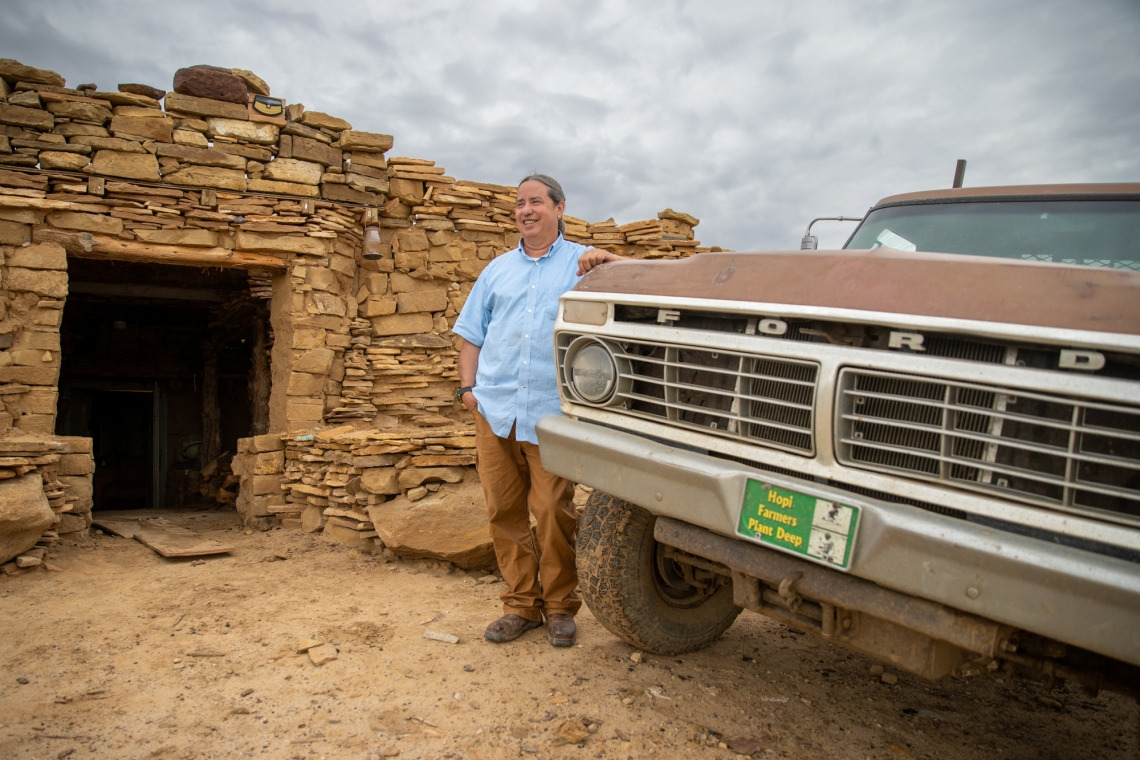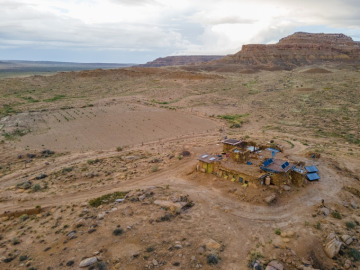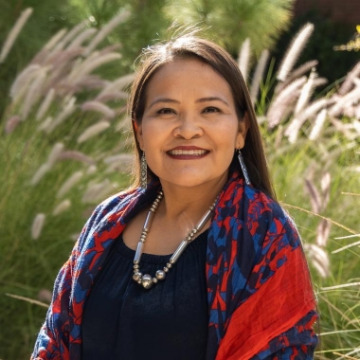Indigenous Resilience Center is a 'seed' for tribal leaders to water and nurture

Michael Kotutwa Johnson outside his home near Kykotsmovi Village on the Hopi reservation in northeastern Arizona. Johnson joined the university last summer as an assistant specialist in the School of Natural Resources and the Environment, and is affiliated with the UArizona Indigenous Resilience Center.
Kyle Mittan

Johnson's crops include dozens of varieties of corn, beans, melons and squash, all of which grow on 6 to 10 inches of annual rainfall in an area without natural rivers.
Kyle Mittan
Farmers from Oregon, Montana or other northwestern states occasionally call Michael Kotutwa Johnson to ask him for advice on dry farming, a method of agriculture in which Johnson is an expert.
The farmers usually say they're doing dry farming because their water sources are increasingly scarce. Rivers may not be as full as they once were, or urban growth might be encroaching on supplies that once served their farms. So, they irrigate less, or they rely largely on rainfall.
But when Johnson asks for more details, he learns that many of these farmers are farming in areas that get 15 to 30 inches of annual rainfall. That's not quite the same as the dry farming Johnson has been doing for 20 years, which involves planting seeds much deeper than conventional farms would or grouping crops closer together – practices designed to conserve the moisture his crops receive from only 6 to 10 inches of annual rain and snowfall in an area that has no natural rivers.
It's the kind of farming his family has done for centuries.
Johnson, a member of the Hopi Tribe of northern Arizona, is an assistant specialist in the University of Arizona School of Natural Resources and the Environment in the College of Agriculture, Life and Environmental Sciences. To that role, he brings decades of experience farming corn, beans and melons on his land near Kykotsmovi Village on the Hopi reservation, which receives only 6 to 10 inches of rainfall a year.
"That, to me, is the heart of who I am as a Hopi – it's practicing that farming," Johnson said one evening in late July at his house, which he built by hand out of sandstone. A light drizzle of rain – a small contribution to the year's 6 to 10 inches – dampened his crops outside.
Johnson is one of the first faculty members to join the UArizona Indigenous Resilience Center. He adds to the center's growing roster of Indigenous scientists focused on helping Native American tribes become resilient to rising climate challenges.
Johnson said he wants Indigenous voices to be more readily heard in the conversation about climate solutions.
"We have over 3,000 years in this particular place, a lot of tribes have even longer in their different areas. But nobody asks them, 'What are we going to do about the environment?'" Johnson said. "I think that's kind of sad, because there's so much knowledge that we still have."

Karletta Chief
The Indigenous Resilience Center, known as IRes, has been in "turbo mode" since it was established in September 2021, said its director, Karletta Chief, a renowned Diné hydrologist and a University Distinguished Outreach Professor of environmental science in the College of Agriculture, Life and Environmental Sciences.
In its first year, IRes brought on experts such as Johnson, held meetings with tribal leaders to learn how the center can better serve tribal communities, and built on research projects that existed before the center was established. All are steps toward the IRes mission, which involves pairing university resources and research with the knowledge and practices tribes have used for millennia to manage their lands and ways of life, Chief said.
The goal, she added, is to help Indigenous communities thrive and adapt to environmental and societal challenges.
"What we're trying to do is be a center that could be a good relative to Indigenous peoples, where they can have access to science, to research, to faculty, to students who want to come back to work with Indigenous communities," she added.
The state of Arizona is home to 22 federally recognized tribes, and a third of the state's land is tribal land. The university's main campus is on the traditional homelands of the Pascua Yaqui Tribe and the Tohono O'odham Nation.
As the state's land-grant university, UArizona is uniquely positioned to do the work IRes has undertaken, Chief said.
"The University of Arizona is in the prime situation to have this type of center," Chief said, adding that IRes complements many centers and programs on campus that focus on issues related to Indigenous peoples. "But there's nothing like the Indigenous Resilience Center, where we focus on environmental solutions, designed with tribes, that is Indigenous-led, and I think that's what makes us unique."
Chief and IRes staff and faculty have spent the last few months meeting with tribal leaders as part of the center's ongoing dialogue with Native American communities to understand their needs how IRes can help.
One comment during a recent meeting that stood out, Chief said, came from Ned Norris Jr., chairman of the Tohono O'odham Nation, who simply asked for honesty and transparency about the center's intentions and goals.
"I told him that the Indigenous Resilience Center is a seed right now," Chief said. "We want tribal leaders and tribal nations to water that seed, nurture it and help it to grow into a plant that they desire to cultivate and harvest."

